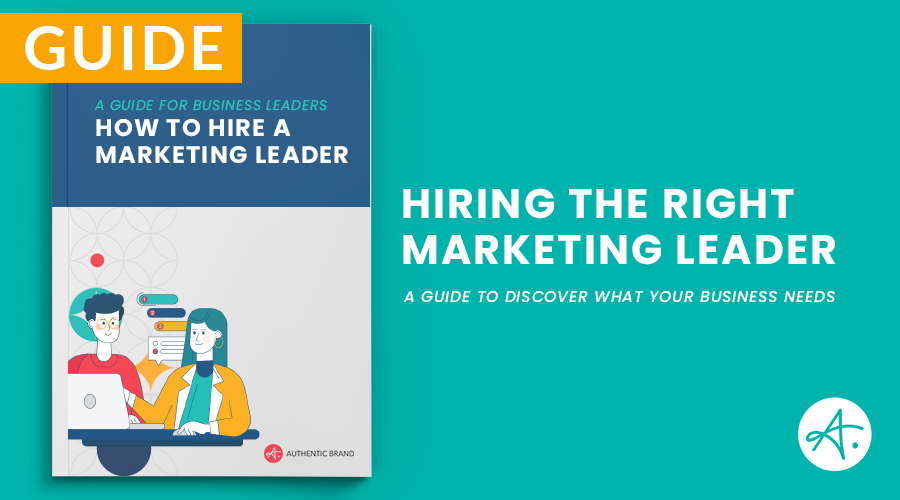
The task to hire the right marketing leader has become increasingly difficult. Growing businesses need experienced marketing direction, and they can’t afford to get this hire wrong. A bad hire in the marketing leadership role is not only painful from a talent turn-over and expense perspective, but it runs the risk of damaging the company’s overall brand reputation, culture, and revenue potential.
This reality begs some important questions, which we’ll address in this Guide to hiring a marketing leader:
- Why is it so hard to hire a marketing leader?
- How can businesses confidently bring strong marketing leadership to the table?
- How can businesses successfully navigate the messiness that comes with hiring?
Addressing a lack of trust and misaligned expectations
First, the facts. Chief marketing officers (CMOs) have it hard. In fact, the CMO role is well documented as having the shortest lifespan in the entire C-suite. SpencerStuart’s CMO Tenure Report recently found that the median CMO tenure in 2020 dropped to 25.5 months, the lowest on record. Marketing roles, in general, have the highest turnover rates of any profession.
In addition to lack of tenure, there’s a significant lack of trust on both sides of the table. An Adweek article sums up the sentiment well:
A global survey of CEOs by the Fournaise Marketing Group revealed that 80 percent of them don’t trust or are “unimpressed” with their CMOs, whereas only 10 percent feel the same way about their CFO or CIO. That sentiment cuts both ways: Harvard Business Review found that 74 percent of CMOs believe they aren’t being allowed to exert maximum business impact for reasons ranging from unrealistic expectations to misaligned performance metrics.
There’s a lot of pain and missed expectations on both sides of these statistics. And as the marketing landscape grows and new technologies emerge, it’s not getting any easier for companies to hire confidently for the CMO role.

Let’s start with a look in the rear-view mirror. Twenty years ago, in the late ‘90s, the internet was a shiny new object, and companies were building their first-ever “online brochures.” While the promise of innovation and disruptive marketing strategies peeked up from the horizon, the actual toolbox for sales and marketing leaders was traditional and simple.
Back then (which feels like several marketing lifetimes ago, but in reality, is relatively recent history), the typical marketing plan included print advertising, public relations, sponsorships, collateral, and an outbound calling list. Websites, SEO, and e-Commerce were just beginning to emerge and were considered more experimental than necessary.
In that emerging-internet era, the most important skills for a marketing leader included: general communications, creativity, branding, and agency relationship management. Hiring a marketer for these credentials was fairly straightforward. The recipe for success was predictable.
Today’s marketing landscape requires new skills
Fast-forward to today: digital capabilities and extreme shifts in buyer behaviors and expectations have completely reshaped the marketing world. With exponentially-increasing access to information and competitively priced options, buyers – both B2C and B2B – interact with businesses, and their brands and sales organizations, much differently than they did just one or two decades ago.
Technologies have emerged at a break-neck pace to support the ever-evolving customer lifecycle. Today’s marketing plan must consider a universe of options to prescribe the ideal blend of owned, paid, and earned media. Within those three seemingly simple categories, the balance and integration of programs, campaigns, content, and activities are truly unlimited.
In today’s digitally-driven era, the most important skills for a marketing leader have shifted tremendously. Fundamental communication, creative, brand, and leadership skills are still essential. But now add: data, analytics, funnel and lifecycle strategy, content strategy, demand generation, digital product innovation, advocacy and retention, sales enablement…and the list goes on.
The hiring recipe has changed
So, why is it so hard for companies to hire a strong marketing leader? Because the game has changed, and most businesses haven’t caught up. Companies are hiring using an outdated recipe rather than seeking a master chef who can design the custom menu that they need.
In this ecosystem of extreme complexity and limitless shiny objects, the most important ingredient a marketing leader can bring to the table is focus. No marketer can do it all, and no marketing organization or business can do it all.
Strong brands are built by strong leaders who can see the big picture to effectively eliminate distractions and direct resources to high-value outcomes.

According to the U.S. Department of Labor, the cost of a bad hire can equal up to 30 percent of the employee’s potential first-year earnings. Despite how difficult and risky it is to hire a marketing leader, businesses need marketing more than ever. While the sales team was once the primary owner of the customer conversation, marketing increasingly supports today’s buyers through a large portion of the buyer’s journey.
To compete and stay relevant, businesses need a strong marketing strategy and program supported by experienced leadership. Getting the marketing leadership role right starts with setting realistic expectations. Here’s a jump start on what you should — and shouldn’t — expect when hiring a marketing leader, including why it’s best to hire long before you need growth.
No marketer can — or should — do it all
At Authentic, we work primarily with small and mid-sized businesses, often between $5-100M in annual revenue. Many of these organizations have never had a senior marketing leader, and some have never had a full-time marketer.
Meanwhile, almost all of our clients have established sales organizations and brands (but they’re not necessarily organized). Our clients recognize that to reach their next-level growth goals, they need experienced marketing leadership at the helm. But they aren’t sure what this leader will do. Will they just strategize and manage? Will they roll their sleeves up and execute?
For small and mid-sized businesses, the answer is yes and yes. A marketing leader must balance both sides while helping the business engage tactical support around specific areas that require specialized expertise (e.g., website development, content production, search engine marketing, and event strategy). No single marketer (or agency resource, for that matter) can have deep expertise in every marketing strategy, technology, or tactic. Executing marketing plans requires the right specialized support at the right time.
CMOs (or any marketing leader) must be able to see the big picture while managing and integrating internal teams, external service providers, and tactics in a way that moves the business forward. As the business grows, the marketing leadership role will continue to lean more heavily toward strategy, management, and building the teams and programs that keep day-to-day tactics aligned with the overall business goals.
Marketing impact takes time — more than your business would like
Many CEOs and CFOs nod their heads when we tell them that marketing takes time. Then 90 days later, impatience sets in, and everyone is asking when “all of this marketing activity is going to produce measurable ROI.”
Let’s review some math that might help clear up expectations on the timeline.
+3-6 months The amount of time it will take a new marketing leader to get up to speed on your culture, products, services, stakeholders, current initiatives, talent, vendor relationships, platforms, and data — all while managing whatever commitments you already have in place for advertising, events, internal reports, and meetings. In other words, making sure no wheels fall off the bus while s/he evaluates what needs to stay, go, or change.
+3 months: Once your marketing leader has the lay of the land and chaos under control, they can introduce new ideas. Most new ideas need development: planning, design, content, campaign infrastructure, launch, follow-up, and more.
+12 months: Once ideas are in action, they must stay in action with constant review, measurement, iteration, and evolution. It often takes an organization an entire 12-month cycle to even capture baseline metrics so that, going forward, they can understand the incremental impact. Meanwhile, we know it takes 7-15 “touches” to build awareness and interest with would-be prospects. This requires brand-building and program evolution.
+18 months: Those initial programs successfully captured new interest and built awareness, and now net-new leads are hitting the pipeline. Let’s follow just one of those leads through their lifecycle with your business:
For many B2B organizations, lead generation is the first step in a 12-24 month sales cycle. Marketing should stay involved long after the team hands a lead off to sales to support a complex B2B buyer’s journey that often includes 5-7 internal stakeholders weighing in on the purchase decision. Sales and marketing must be well-aligned to provide information, address questions, and provide a seamless experience and transfer of trust all the way from initial inquiry to initial win.
+12 more months: It took a year to close the initial deal, but it will take another year (or more!) to realize the full potential of the account. Marketing’s job is still not done. In fact, the richest opportunity is now emerging for marketing to partner closely with sales to nurture the account and every relationship connected to it. This account-based marketing approach ensures that the return on the investment made in acquiring the customer is maximized through strong retention, advocacy, and referrals.
If we add this up, we get 48-51 months. Or, in other words, at least four years of strategic marketing development and growth! Plus, at this point in the marketing lifecycle the complete ROI impact is still building. The magic is in the momentum, and the momentum takes time. This is precisely why we encourage clients to begin investing in marketing — guided by experienced leadership — well before they need growth.

We wish we could promise your business that your marketing journey would be nothing but a joyride. But that would be a lie. It’s going to get worse before it gets better. More likely than not, your marketing leader will be stepping into a world that’s been running on random acts of marketing.
There may need to be some heavy-duty house cleaning before your new leader can establish a strong and healthy platform for growth. The most likely scenario is that they will need to do all or some of the following:
- Reset messaging from a “What” to a “So What” story
- Assess budgets and re-allocate spend to avoid waste, redundancy, or outdated/ineffective programs
- Inventory sales enablement content and collateral, and create new or updated assets that will help your sellers convert more of what is already in your pipeline
- Review and clean customer and prospect databases
- Consolidate, integrate, or upgrade marketing systems
- Improve your website’s usability, structure, and brand experience to enhance engagement
- Potentially refresh your brand and creative (this is rarely the first thing on the list, regardless of what your creative agency tells you)
Even if you’ve already done a lot of the heavy lifting to put a strong foundation in place, there is always more work to be done. Whether in systems, data, talent, culture, metrics, or overall processes — when you bring an experienced marketing leader on board, they will turn over rocks and bugs will come wiggling out. Get ready for some ugly before things look pretty.
There is no straight line between budget and ROI in B2B marketing
Remember how it takes at least four years to build a strategic marketing program? Put that entire four-year life cycle together and compound it with 5-7 stakeholders per client account. How many touchpoints, across how many months and relationships does marketing need to support to attract, win, and retain clients?
There are plenty of technology platforms to help us track the effectiveness of any particular piece of content or a specific lead generation tactic. But it’s difficult – and often fruitless — to try to delineate “revenue sourced by marketing” and “revenue sourced by sales.” Not to mention the value of marketing support for overall culture, talent acquisition, employee engagement, internal communications, product innovation, and other non-ROI-linear, but still essential, growth drivers. ROI is important, but it’s also incredibly nuanced.
All ships rise when marketing does its job well across the full customer lifecycle and in support of the entire business. It shouldn’t be a matter of determining who gets the credit. Instead, it’s how your organization can best invest in marketing to support a revenue engine capable of driving next-level growth and success.
Don’t expect “quick wins” and “low-hanging fruit”
“Quick wins” and “low-hanging fruit” are terms with a high marketing cringe factor. Unless your sales team has a qualified deal already sitting at the bottom of your pipeline, your business is not going to get quick wins. At least not the kind of quick wins that fuel healthy, sustainable, predictable growth. These phrases — spoken from the well-meaning mouths of CEOs, CFOs and sales leaders — are to blame for all of the money wasted on random acts of marketing, spray and pray marketing tactics that desperately seek engagement but rarely lead to conversion or retention.
Marketing is a long game, it begins with the end (revenue) in mind and then backs up with a strategic road map for how marketing supports the buyer and the business at every step. Refer back to “marketing impact takes time” section in this guide for an idea of what businesses need to do to bring this long game to life to support long-term growth and organizational health.
Do expect focus, accountability, and constant iteration
You may think that we’re building a case for unlimited marketing runway, spend, and autonomy. Not so. Too many marketing teams operate on an island, disconnected from the broader business, and tragically, from the sales process.
Strong marketing leaders work in lockstep with executives and sales leaders — setting out a clear vision that aligns with the overall goals of the business, and providing regular insight into marketing activities, successes, and failures. Alignment and accountability are two key ingredients in Authentic’s Authentic Growth Methodology™; setting the stage for focused and iterative execution.
A hiring solution: Experienced leadership on a part-time, flexible basis
Without an experienced marketer on staff, it’s difficult to know the type of marketer your business needs. The good news is you don’t have to hire a full-time employee to get experienced leadership. Fractional CMOs are a strong option, providing businesses with strategic and experienced leadership on a part-time, flexible basis for a quicker impact and lower risk than a full-time hire.
Authentic Fractional CMOs™ have worked across industries, markets, and business types to help businesses Overcome Random Acts of Marketing® and achieve revenue results. Let’s discuss how Authentic’s model, supported by a strong methodology and mindshare, can help your organization achieve its next-level growth.





